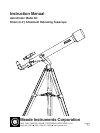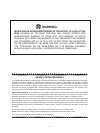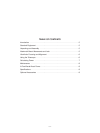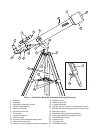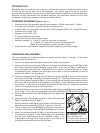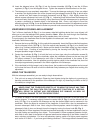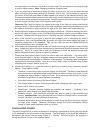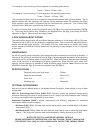
– 5 –
INTRODUCTION
Before you begin your visual journey, we urge you to take a few minutes to completely read this manual
so that you can get the best use of the equipment. This manual details the set-up, operation,
specifications and optional accessories of the AstroFinder Model 60 altazimuth refracting telescope.
Designed for both astronomical and terrestrial observing, the AstroFinder Model 60 will be your
companion in exploring a universe of celestial and earthly objects.
STANDARD EQUIPMENT (Refer to Fig. 1)
• Complete optical tube assembly (objective lens diameter = 60mm; focal length = 700mm)
• Full-length, fully adjustable, aluminum tripod and accessory tray.
• H 25mm (28X), H 12.5mm (56X), and SR 4mm (175X) Eyepieces (0.965" O.D. “Outside Diameter”)
• 3x Barlow Lens (0.965" O.D.)
• Diagonal mirror (0.965" O.D.)
• 5 x 24mm viewfinder with bracket
• Altazimuth mount with micro-altitude control
• Hardware package: A. 3 bolts (3" long) with wing nuts and washers
B. 3 screws (1/2" long) with wing nuts and screwdriver tool
Note: All other necessary hardware provided in place.
• StarFinder astronomy software (separate instructions supplied in software package)
UNPACKING AND ASSEMBLY
First time assembly of the telescope should not require more than about 15 minutes. To set up the
telescope, follow this procedure:
1. Remove and identify the telescope’s components, using the listing above.
2. Attach the 3 aluminum tripod legs (7, Fig. 1) to the base of the altazimuth mount (10, Fig. 1) with
the 3 hinged leg brace supports (8, Fig. 1) facing inward. Three bolts (11, Fig. 1), each about 3"
long, with washers and wing nuts, are provided for this purpose in hardware package “A.” Stand
the telescope upright, spreading the tripod legs evenly apart so that the accessory tray can be
positioned to attach to the 3 leg braces.
3. Attach the accessory tray (9, Fig. 1) to the leg brace supports (8, Fig. 1) with the 3 short screws
and wing nuts (12, Fig. 1) provided in hardware package “B.” Place the accessory tray on top of
one of the leg brace supports (8, Fig. 1) of the tripod so that the mounting screw passes through
the hole at one of the corners of the accessory tray (9, Fig. 1), and through the hole at the end of
the leg brace. Then thread-on and tighten the wing nut to a firm feel only. Repeat this procedure
until all 3 corners are mounted to the 3 leg braces.
4. Extend the sliding center portion of the adjustable height tripod leg (19, Fig. 1) to the desired length
for all 3 legs. Lock in place by tightening the leg lock thumbscrew (20, Fig. 1) to a firm feel.
5. Remove the two vertical lock knobs (D, Fig. 2) from the optical tube
assembly.
6. Place the optical tube between the forks of the azimuth mount (A,
Fig. 2), oriented as shown in Fig. 2.
7. Slide the altitude rod (B, Fig. 2) into the hole in the altitude coarse
adjustment control assembly (C, Fig. 2). Tighten to a firm feel.
8. Thread a vertical lock knob (D, Fig. 2) through each of the holes in
the forks of the azimuth mount (A, Fig. 2) and tighten to a firm feel.
9. Attach the viewfinder bracket (2, Fig. 1) to the telescope using the
2 thumbscrews provided. These thumbscrews are pre-threaded
into the main telescope tube at the viewfinder location. The
thumbscrews fit through the 2 holes located at the base of the
viewfinder bracket and thread into the main tube.
Fig. 2 Mounting the optical
tube assembly: (A) azimuth
mount; (B) altitude rod;
(C) altitude coarse adjustment
control; (D) vertical lock knob.
B A
C
D



